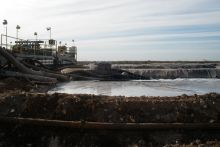
Energy Information Administration FAQs:
"The U.S. Energy Information Administration estimates that as of January 1, 2016, there were about 2,462 trillion cubic feet (Tcf) of technically recoverable resources of dry natural gas in the United States. At the rate of U.S. natural gas consumption in 2016 of about 27.5 Tcf per year, the United States has enough natural gas to last about 90 years. The actual number of years will depend on the amount of natural gas consumed each year, natural gas imports and exports, and additions to natural gas reserves.
Technically recoverable reserves consist of proved reserves and unproved resources. Proved reserves of crude oil and natural gas are the estimated volumes expected to be produced, with reasonable certainty, under existing economic and operating conditions. Unproved resources of crude oil and natural gas are additional volumes estimated to be technically recoverable without consideration of economics or operating conditions, based on the application of current technology."
Learn More:
- America's Increasing Reliance on Natural Gas: Benefits and Risks of a Methane Economy: Report of the Critical Issues Forum (Report), American Geosciences Institute
An overview of the key conceptual ideas that arose in the Critical Issues 2014 forum on natural gas and the American economy
- Today in Energy: Geology and Technology Drive Estimate of Technically Recoverable Resources (Web Article), Energy Information Administration
Summary of what technically recoverable resource estimates for natural gas are and how technology changes modify the estimates
- Natural Gas Consumption by End-Use (Data), Energy Information Administration
Statistics on U.S. natural gas consumption for a range of uses
- Annual Energy Outlook (Website), Energy Information Administration
Annual report on energy in the U.S., including natural gas production, consumption, price, and trade, including future projections.






